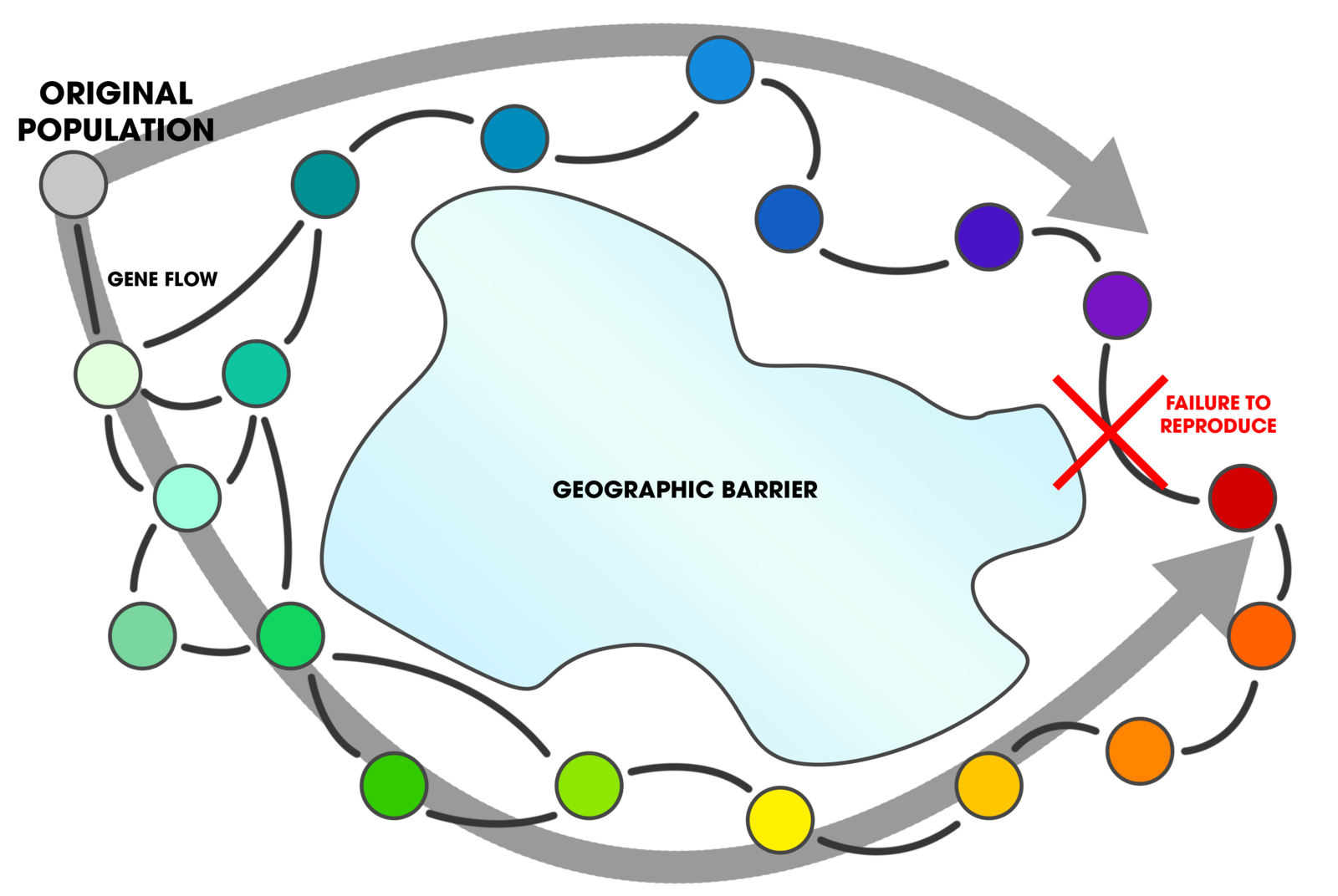IB Syllabus focus:
‘Isolated populations adapt to different conditions; over time, reproductive barriers form and interbreeding with the original population ceases, producing new species.’
Speciation is the evolutionary process by which new species arise. It occurs when populations become separated and adapt to different environments, eventually preventing interbreeding between groups.
The Concept of Speciation
Speciation is the process by which populations diverge genetically to the extent that they become distinct species. This is central to understanding biodiversity and evolutionary change. It requires both isolation and adaptation.
Speciation: The formation of new and distinct species in the course of evolution.
A new species is recognised when individuals of one group can no longer successfully breed with individuals from the original population, creating a reproductive barrier.
Types of Isolation
Isolation is the starting point for speciation, as it prevents populations from mixing genes. There are several key forms:
Geographical isolation (allopatric speciation): Physical barriers such as mountains, rivers, or oceans separate populations.

A simplified schematic of allopatric speciation: a geographical barrier splits an ancestral population, gene flow stops, and each daughter population adapts until reproductive isolation evolves. The diagram clearly labels the barrier, isolated populations, and the resulting species. Source.
Ecological isolation: Populations occupy different habitats or ecological niches, even in the same region.
Temporal isolation: Species breed at different times of the day, season, or year.
Behavioural isolation: Differences in mating behaviours or courtship rituals prevent interbreeding.
Mechanical isolation: Incompatibility of reproductive organs or pollination mechanisms.
Reproductive barrier: A biological or behavioural feature that prevents members of two populations from interbreeding successfully.
Each form of isolation limits gene flow, enabling divergence between groups.

Diagram of a ring species showing populations encircling a barrier that interbreed with neighbours, yet the divergent endpoints no longer interbreed where they meet—evidence of reproductive isolation. The arrows indicating gene flow are an extra detail beyond the syllabus, but they clarify how isolation patterns emerge. Source.
Adaptation to New Conditions
Once isolated, populations face distinct selective pressures in their environments. Over generations, advantageous traits are favoured by natural selection.
Variation exists naturally in all populations.
Environmental conditions differ across habitats.
Individuals with beneficial adaptations survive and reproduce.
Advantageous alleles increase in frequency in the population.
This gradual accumulation of adaptations makes populations increasingly distinct. For example, finches on different Galápagos Islands developed varied beak shapes adapted to food sources, eventually becoming separate species.
Role of Natural Selection in Speciation
Natural selection ensures that populations adapt to their unique environments. This leads to divergence between isolated groups.
Key points:
Overproduction of offspring creates competition for resources.
Variation allows some individuals to cope better with local conditions.
Differential survival and reproduction favour advantageous traits.
Accumulation of changes over many generations strengthens divergence.
When differences become too great, reproductive barriers solidify, and speciation is complete.
Processes of Speciation
Speciation can occur through different evolutionary pathways:
Allopatric Speciation
Geographic isolation is the initial driver.
Populations adapt separately to distinct conditions.
Over time, genetic differences accumulate, leading to reproductive isolation.
Sympatric Speciation
Occurs without physical separation.
Caused by ecological, behavioural, or genetic isolation within the same area.
Examples include insects specialising on different host plants.

UCMP schematic of sympatric speciation: new species arise within an overlapping range via niche or behavioural shifts that reduce gene flow. This clean figure focuses exactly on the IB-required idea that isolation can be ecological/behavioural rather than geographic. Source.
Parapatric Speciation
Populations remain adjacent but occupy different environments.
Limited gene flow combined with local adaptation drives divergence.
Genetic Mechanisms in Speciation
Genetic change underlies the divergence of populations:
Mutation introduces new alleles, sometimes advantageous in one environment but not another.
Genetic drift alters allele frequencies by chance, especially in small populations.
Gene flow is restricted by isolation, allowing unique adaptations to spread within populations.
Allele frequency: The proportion of a particular allele among all allele copies in a population.
These genetic mechanisms, combined with natural selection, explain how populations become reproductively isolated.
Reproductive Barriers and Species Formation
Reproductive isolation is the final step in speciation. Once established, even if populations come back into contact, they remain separate species. These barriers can be:
Prezygotic barriers (before fertilisation):
Temporal isolation
Behavioural differences
Mechanical incompatibility
Postzygotic barriers (after fertilisation):
Hybrid inviability (offspring fail to develop)
Hybrid sterility (offspring cannot reproduce, e.g., mules)
Over evolutionary time, these barriers prevent genetic mixing, preserving distinct lineages.
The Importance of Speciation for Biodiversity
Speciation is the foundation of biodiversity, driving the variety of life observed today. By generating new species, ecosystems gain resilience and adaptability. Isolated populations adapting to different conditions increase the diversity of traits, ecological roles, and interactions within and between ecosystems.
Biodiversity at the species level depends on speciation continuing across geological time. Without it, the capacity of ecosystems to recover from disturbances would be greatly reduced.
Case Examples
While IB ESS does not demand extensive case study analysis, examples clarify the process:
Darwin’s finches (Galápagos Islands): Different islands produced finch species with unique beak adaptations.
Cichlid fishes (African lakes): Hundreds of species evolved rapidly through ecological specialisation and sexual selection.
Polar and brown bears: Divergence in climate and habitat created reproductively distinct species despite a common ancestor.
These examples illustrate speciation through both isolation and adaptation, central to evolutionary processes.
FAQ
Allopatric speciation occurs when a physical barrier separates populations, preventing gene flow. Over time, adaptations to different environments lead to reproductive isolation.
Sympatric speciation occurs without a physical barrier. Instead, ecological niches, behaviour, or genetic changes reduce gene flow, even though populations remain in the same geographic area.
Without variation, populations cannot respond to different selective pressures in their environments. Mutations and recombination provide the raw material for natural selection.
Variation allows some individuals to survive changes in conditions. Over generations, these advantageous traits accumulate, increasing differences between isolated groups until reproductive barriers form.
Reproductive barriers develop gradually as populations adapt to unique conditions. They may occur before fertilisation (prezygotic) or after fertilisation (postzygotic).
Prezygotic: differences in timing, behaviour, or anatomy prevent mating.
Postzygotic: hybrid offspring may be sterile or inviable.
These barriers ensure populations remain genetically distinct.
Environmental pressures act as selective forces shaping populations. Examples include:
Food availability influencing feeding structures.
Predation pressures favouring camouflage or defensive traits.
Climate differences selecting for tolerance to temperature or water stress.
Over time, these pressures drive populations towards unique adaptations, reinforcing divergence.
Darwin’s finches provide clear evidence of how isolation and adaptation work together. On different islands, populations faced unique food sources.
This led to changes in beak size and shape, directly linked to diet. The variety of finches today illustrates how small adaptations can accumulate into full reproductive isolation and new species formation.
Practice Questions
Question 1 (2 marks)
Define the term speciation and outline the role of isolation in this process.
Mark scheme:
Definition of speciation: formation of new and distinct species in the course of evolution (1 mark).
Reference to isolation preventing gene flow between populations (1 mark).
Question 2 (5 marks)
Explain how natural selection and adaptation lead to the formation of new species in geographically isolated populations.
Mark scheme:
Statement that geographic isolation prevents interbreeding/gene flow between populations (1 mark).
Reference to variation within populations (genetic differences, mutations) (1 mark).
Explanation that different environments impose different selective pressures (1 mark).
Individuals with advantageous adaptations survive and reproduce, increasing frequency of those traits (1 mark).
Over generations, accumulated differences create reproductive barriers and result in new species (1 mark).

